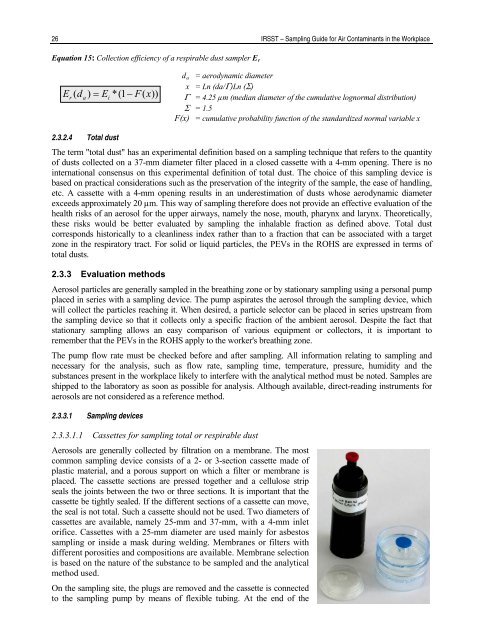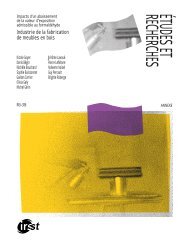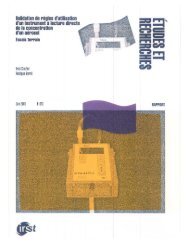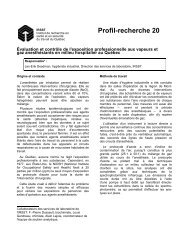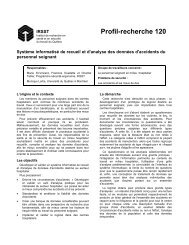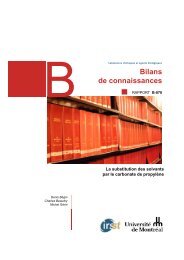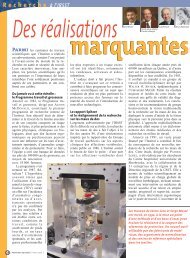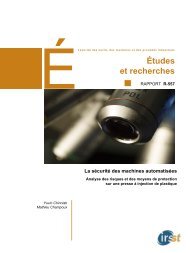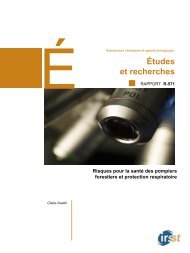Sampling Guide for Air Contaminants in the Workplace - Irsst
Sampling Guide for Air Contaminants in the Workplace - Irsst
Sampling Guide for Air Contaminants in the Workplace - Irsst
You also want an ePaper? Increase the reach of your titles
YUMPU automatically turns print PDFs into web optimized ePapers that Google loves.
26 IRSST – <strong>Sampl<strong>in</strong>g</strong> <strong>Guide</strong> <strong>for</strong> <strong>Air</strong> <strong>Contam<strong>in</strong>ants</strong> <strong>in</strong> <strong>the</strong> <strong>Workplace</strong><br />
Equation 15: Collection efficiency of a respirable dust sampler E r<br />
E ( d ) = E *(1 − F(<br />
x))<br />
r<br />
a<br />
i<br />
d a = aerodynamic diameter<br />
x = Ln (da/Γ)Ln (Σ)<br />
Γ = 4.25 µm (median diameter of <strong>the</strong> cumulative lognormal distribution)<br />
Σ = 1.5<br />
F(x) = cumulative probability function of <strong>the</strong> standardized normal variable x<br />
2.3.2.4 Total dust<br />
The term "total dust" has an experimental def<strong>in</strong>ition based on a sampl<strong>in</strong>g technique that refers to <strong>the</strong> quantity<br />
of dusts collected on a 37-mm diameter filter placed <strong>in</strong> a closed cassette with a 4-mm open<strong>in</strong>g. There is no<br />
<strong>in</strong>ternational consensus on this experimental def<strong>in</strong>ition of total dust. The choice of this sampl<strong>in</strong>g device is<br />
based on practical considerations such as <strong>the</strong> preservation of <strong>the</strong> <strong>in</strong>tegrity of <strong>the</strong> sample, <strong>the</strong> ease of handl<strong>in</strong>g,<br />
etc. A cassette with a 4-mm open<strong>in</strong>g results <strong>in</strong> an underestimation of dusts whose aerodynamic diameter<br />
exceeds approximately 20 µm. This way of sampl<strong>in</strong>g <strong>the</strong>re<strong>for</strong>e does not provide an effective evaluation of <strong>the</strong><br />
health risks of an aerosol <strong>for</strong> <strong>the</strong> upper airways, namely <strong>the</strong> nose, mouth, pharynx and larynx. Theoretically,<br />
<strong>the</strong>se risks would be better evaluated by sampl<strong>in</strong>g <strong>the</strong> <strong>in</strong>halable fraction as def<strong>in</strong>ed above. Total dust<br />
corresponds historically to a cleanl<strong>in</strong>ess <strong>in</strong>dex ra<strong>the</strong>r than to a fraction that can be associated with a target<br />
zone <strong>in</strong> <strong>the</strong> respiratory tract. For solid or liquid particles, <strong>the</strong> PEVs <strong>in</strong> <strong>the</strong> ROHS are expressed <strong>in</strong> terms of<br />
total dusts.<br />
2.3.3 Evaluation methods<br />
Aerosol particles are generally sampled <strong>in</strong> <strong>the</strong> breath<strong>in</strong>g zone or by stationary sampl<strong>in</strong>g us<strong>in</strong>g a personal pump<br />
placed <strong>in</strong> series with a sampl<strong>in</strong>g device. The pump aspirates <strong>the</strong> aerosol through <strong>the</strong> sampl<strong>in</strong>g device, which<br />
will collect <strong>the</strong> particles reach<strong>in</strong>g it. When desired, a particle selector can be placed <strong>in</strong> series upstream from<br />
<strong>the</strong> sampl<strong>in</strong>g device so that it collects only a specific fraction of <strong>the</strong> ambient aerosol. Despite <strong>the</strong> fact that<br />
stationary sampl<strong>in</strong>g allows an easy comparison of various equipment or collectors, it is important to<br />
remember that <strong>the</strong> PEVs <strong>in</strong> <strong>the</strong> ROHS apply to <strong>the</strong> worker's breath<strong>in</strong>g zone.<br />
The pump flow rate must be checked be<strong>for</strong>e and after sampl<strong>in</strong>g. All <strong>in</strong><strong>for</strong>mation relat<strong>in</strong>g to sampl<strong>in</strong>g and<br />
necessary <strong>for</strong> <strong>the</strong> analysis, such as flow rate, sampl<strong>in</strong>g time, temperature, pressure, humidity and <strong>the</strong><br />
substances present <strong>in</strong> <strong>the</strong> workplace likely to <strong>in</strong>terfere with <strong>the</strong> analytical method must be noted. Samples are<br />
shipped to <strong>the</strong> laboratory as soon as possible <strong>for</strong> analysis. Although available, direct-read<strong>in</strong>g <strong>in</strong>struments <strong>for</strong><br />
aerosols are not considered as a reference method.<br />
2.3.3.1 <strong>Sampl<strong>in</strong>g</strong> devices<br />
2.3.3.1.1 Cassettes <strong>for</strong> sampl<strong>in</strong>g total or respirable dust<br />
Aerosols are generally collected by filtration on a membrane. The most<br />
common sampl<strong>in</strong>g device consists of a 2- or 3-section cassette made of<br />
plastic material, and a porous support on which a filter or membrane is<br />
placed. The cassette sections are pressed toge<strong>the</strong>r and a cellulose strip<br />
seals <strong>the</strong> jo<strong>in</strong>ts between <strong>the</strong> two or three sections. It is important that <strong>the</strong><br />
cassette be tightly sealed. If <strong>the</strong> different sections of a cassette can move,<br />
<strong>the</strong> seal is not total. Such a cassette should not be used. Two diameters of<br />
cassettes are available, namely 25-mm and 37-mm, with a 4-mm <strong>in</strong>let<br />
orifice. Cassettes with a 25-mm diameter are used ma<strong>in</strong>ly <strong>for</strong> asbestos<br />
sampl<strong>in</strong>g or <strong>in</strong>side a mask dur<strong>in</strong>g weld<strong>in</strong>g. Membranes or filters with<br />
different porosities and compositions are available. Membrane selection<br />
is based on <strong>the</strong> nature of <strong>the</strong> substance to be sampled and <strong>the</strong> analytical<br />
method used.<br />
On <strong>the</strong> sampl<strong>in</strong>g site, <strong>the</strong> plugs are removed and <strong>the</strong> cassette is connected<br />
to <strong>the</strong> sampl<strong>in</strong>g pump by means of flexible tub<strong>in</strong>g. At <strong>the</strong> end of <strong>the</strong>


